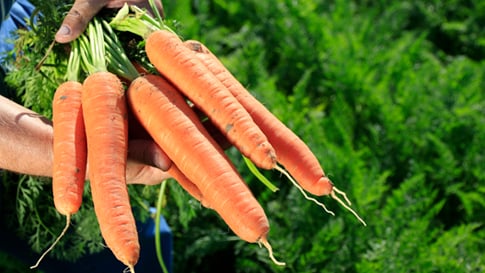Growing Carrots
crop nutrition advice
Everything you need to know about carrot fertilisation, best practice, suitable products, field trials and more.
Advice for growing carrots (Daucus carota)
-
Carrots are one of the most-grown vegetable crops in Haryana, Andhra Pradesh, Karnataka, Punjab, and Uttar Pradesh.
-
Carrot crops require deep, loose loamy soils for optimal root development.
-
The optimum pH range lies between 5.5 and 7.0.
-
At soil pH < 5.5, carrot is susceptible to phosphate, molybdenum, and calcium deficiencies.
-
At soil pH > 7.5, deficiencies of boron, copper, iron, manganese, phosphate, and zinc are likely to appear.

Carrots harvested in optimum condition

Growing carrots
Nutrient requirements
Estimated nutrient uptake (kg/t):
| Early-medium-late varieties (60 ton/ha) | N kg/t | P2O5 kg/t | K2O kg/t | MgO kg/t | CaO kg/t |
|---|---|---|---|---|---|
| Leaves | 60 | 21 | 170 | 13 | 70 |
| Root | 80 | 12 | 151 | 8 | 18 |
| Total | 140 | 33 | 321 | 21 | 88 |
| Late and very late varieties (140 ton/ha) | N kg/t | P2O5 kg/t | K2O kg/t | MgO kg/t | CaO kg/t |
|---|---|---|---|---|---|
| Leaves | 40 | 9 | 97 | 17 | 126 |
| Root | 110 | 69 | 303 | 17 | 56 |
| Total | 150 | 78 | 400 | 34 | 182 |
Recommendations for the different nutrients depends on soil fertility.
Carrot is susceptible to high salt concentrations, especially at the seedling stage.
Fertilisation methods
Nitrogen
Using a granular fertiliser, apply before seeding at approx. 80 kg/ha of N minus N-mineral in the soil (0-60 cm). The rest could be split over the crop cycle either on weekly basis, via fertigation, or with 2-3 applications of conventional granular N-based products.
However, in non-fertigated crops, using controlled release fertilisers (CRF) allows the entire N application to be applied before seeding, avoiding multiple top dressings.
Phosphate
Can be applied entirely at the beginning of the crop cycle, before seeding.
Potassium
Potassium leaches as easily as nitrate, therefore in non-fertigated crop systems the entire amount that crops need should be split in 2-3 applications with conventional K fertilisers, or a single application before seeding if using a coated K-based product.
In fertigated crops, supplying potassium on weekly basis is strongly recommended.
Magnesium
Magnesium should be applied entirely at the beginning of the crop cycle, before seeding. Nevertheless, foliar applications will further improve crop performance.
Calcium
Can be applied entirely at the beginning of the crop cycle, before seeding.
Q&A
Here are some frequently asked questions we received from farmers regarding Growing Carrots
Of course, all nutrients are important, but potassium and calcium are very important to the (skin) quality of carrots.
Potassium chloride improves carrot’s sugar levels. In heavy soils, it should be applied 1-2 months before seeding, while in very light soils it should be 1-2 weeks before seeding. Afterwards, it is recommended to use potassium sulphate-based products.
When the soil content of magnesium is low, always give a base fertiliser with magnesium. Even in rich soils, foliar applications are strongly recommended for improving overall leaf health.
It is recommended that phosphate is always applied close to seeding time.
Commonly, 3 nitrogen applications are applied to carrots to avoid high salt concentrations and nitrogen losses. The best way, however, is to use CRFs (controlled release fertilisers); CRFs can be applied, without the risk of high salt and nitrogen concentration, in a single application before seeding, supplying the plants’ entire nitrogen requirements.
When using fertigation, nitrogen should be applied once a week.


